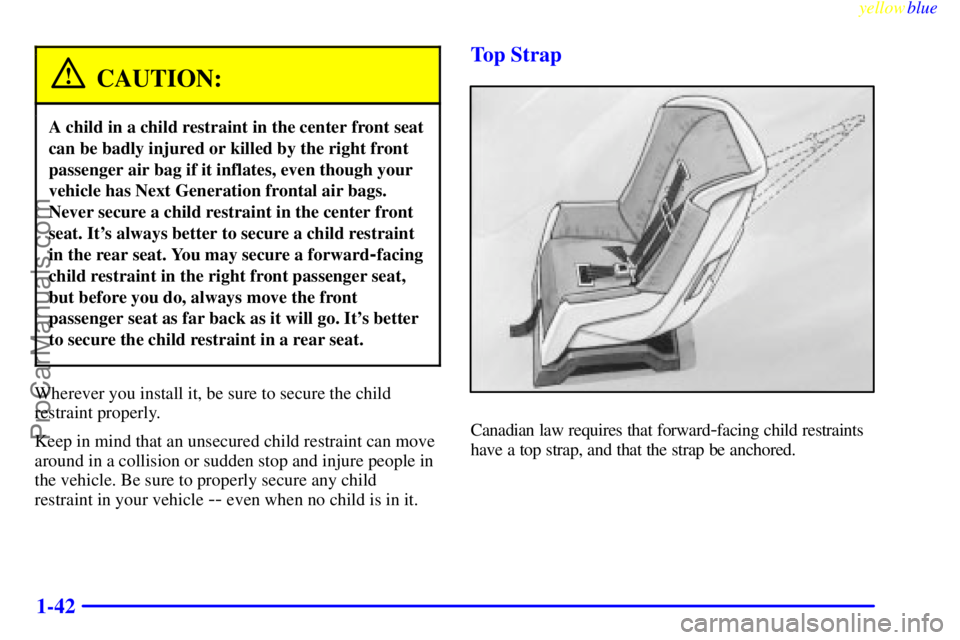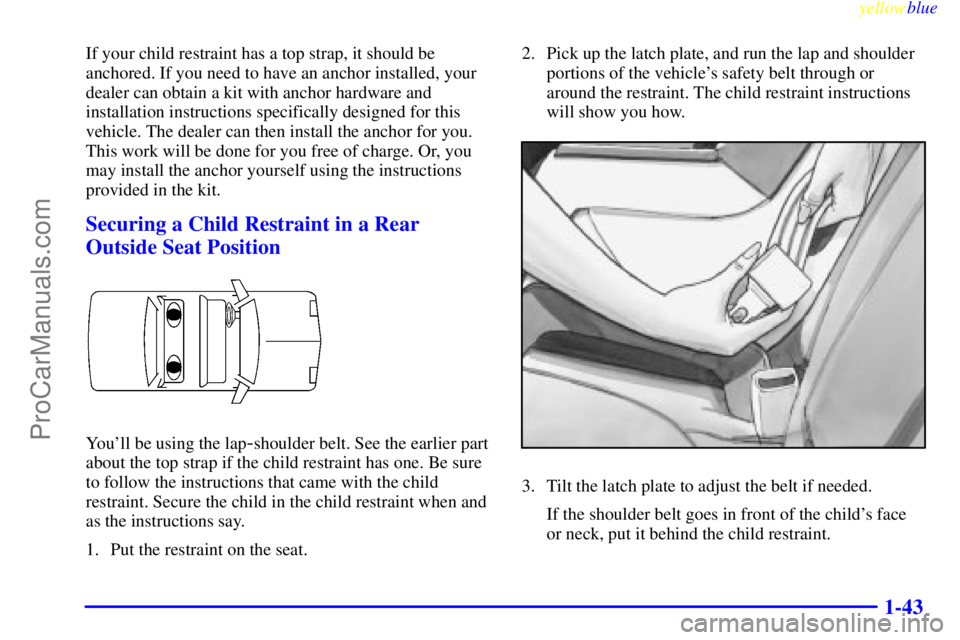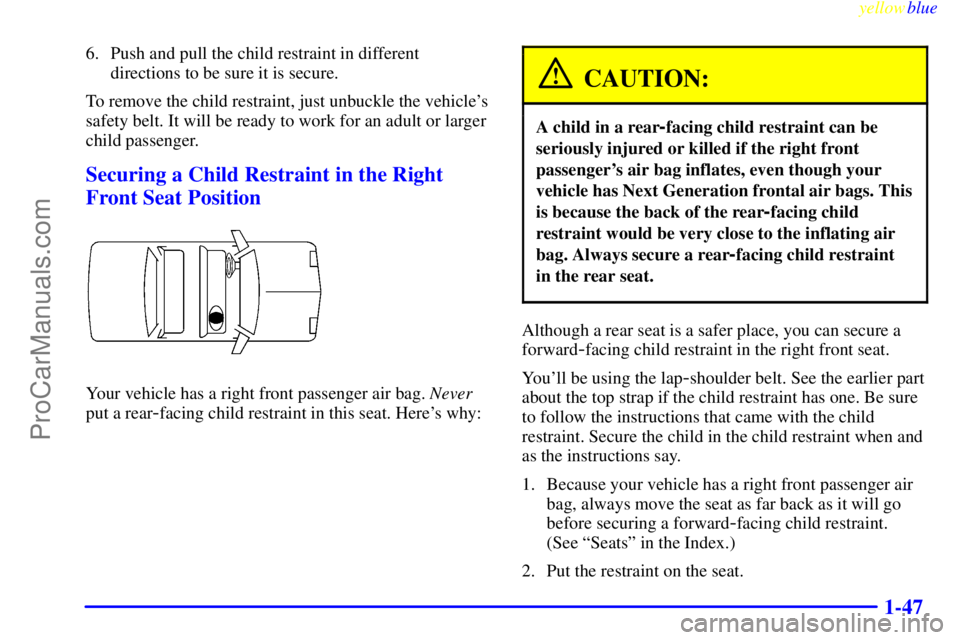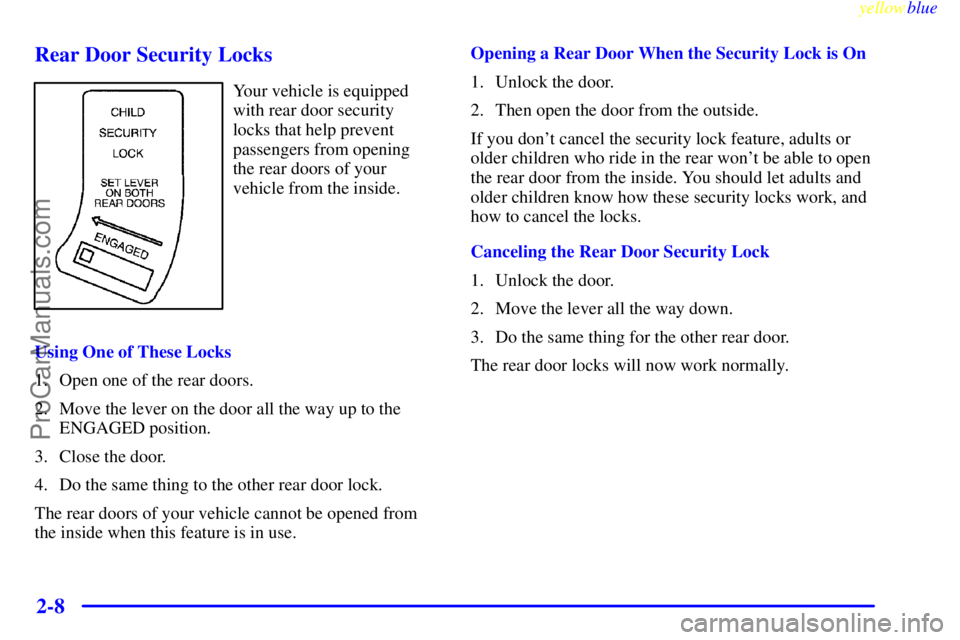Page 48 of 400

yellowblue
1-42
CAUTION:
A child in a child restraint in the center front seat
can be badly injured or killed by the right front
passenger air bag if it inflates, even though your
vehicle has Next Generation frontal air bags.
Never secure a child restraint in the center front
seat. It's always better to secure a child restraint
in the rear seat. You may secure a forward
-facing
child restraint in the right front passenger seat,
but before you do, always move the front
passenger seat as far back as it will go. It's better
to secure the child restraint in a rear seat.
Wherever you install it, be sure to secure the child
restraint properly.
Keep in mind that an unsecured child restraint can move
around in a collision or sudden stop and injure people in
the vehicle. Be sure to properly secure any child
restraint in your vehicle
-- even when no child is in it.
Top Strap
Canadian law requires that forward-facing child restraints
have a top strap, and that the strap be anchored.
ProCarManuals.com
Page 49 of 400

yellowblue
1-43
If your child restraint has a top strap, it should be
anchored. If you need to have an anchor installed, your
dealer can obtain a kit with anchor hardware and
installation instructions specifically designed for this
vehicle. The dealer can then install the anchor for you.
This work will be done for you free of charge. Or, you
may install the anchor yourself using the instructions
provided in the kit.
Securing a Child Restraint in a Rear
Outside Seat Position
You'll be using the lap-shoulder belt. See the earlier part
about the top strap if the child restraint has one. Be sure
to follow the instructions that came with the child
restraint. Secure the child in the child restraint when and
as the instructions say.
1. Put the restraint on the seat.2. Pick up the latch plate, and run the lap and shoulder
portions of the vehicle's safety belt through or
around the restraint. The child restraint instructions
will show you how.
3. Tilt the latch plate to adjust the belt if needed.
If the shoulder belt goes in front of the child's face
or neck, put it behind the child restraint.
ProCarManuals.com
Page 50 of 400
yellowblue
1-44
4. Buckle the belt. Make sure the release button is
positioned so you would be able to unbuckle the
safety belt quickly if you ever had to.5. To tighten the belt, pull up on the shoulder belt while
you push down on the child restraint. If you're using
a forward
-facing child restraint, you may find it
helpful to use your knee to push down on the child
restraint as you tighten the belt.
6. Push and pull the child restraint in different
directions to be sure it is secure.
To remove the child restraint, just unbuckle the vehicle's
safety belt and let it go back all the way. The safety belt
will move freely again and be ready to work for an adult
or larger child passenger.
ProCarManuals.com
Page 51 of 400
yellowblue
1-45 Securing a Child Restraint in the Center
Rear Seat Position
You'll be using the lap belt. Be sure to follow the
instructions that came with the child restraint. Secure
the child in the child restraint when and as the
instructions say.
CAUTION:
A child in a child restraint in the center front
seat can be badly injured or killed by the right
front passenger air bag if it inflates even though
your vehicle has Next Generation frontal air
bags. Never secure a child restraint in the center
front seat. It's always better to secure a child
restraint in the rear seat. You may secure a
forward
-facing child restraint in the right front
passenger seat, but before you do, always move
the front passenger seat as far back as it will go.
It's better to secure the child restraint in a
rear seat.
See the earlier part about the top strap if the child
restraint has one.
ProCarManuals.com
Page 53 of 400

yellowblue
1-47
6. Push and pull the child restraint in different
directions to be sure it is secure.
To remove the child restraint, just unbuckle the vehicle's
safety belt. It will be ready to work for an adult or larger
child passenger.
Securing a Child Restraint in the Right
Front Seat Position
Your vehicle has a right front passenger air bag. Never
put a rear
-facing child restraint in this seat. Here's why:
CAUTION:
A child in a rear-facing child restraint can be
seriously injured or killed if the right front
passenger's air bag inflates, even though your
vehicle has Next Generation frontal air bags. This
is because the back of the rear
-facing child
restraint would be very close to the inflating air
bag. Always secure a rear
-facing child restraint
in the rear seat.
Although a rear seat is a safer place, you can secure a
forward
-facing child restraint in the right front seat.
You'll be using the lap
-shoulder belt. See the earlier part
about the top strap if the child restraint has one. Be sure
to follow the instructions that came with the child
restraint. Secure the child in the child restraint when and
as the instructions say.
1. Because your vehicle has a right front passenger air
bag, always move the seat as far back as it will go
before securing a forward
-facing child restraint.
(See ªSeatsº in the Index.)
2. Put the restraint on the seat.
ProCarManuals.com
Page 55 of 400
yellowblue
1-49
6. To tighten the belt, feed the lap belt back into the
retractor while you push down on the child restraint.
You may find it helpful to use your knee to push
down on the child restraint as you tighten the belt.
7. Push and pull the child restraint in different
directions to be sure it is secure.
To remove the child restraint, just unbuckle the vehicle's
safety belt and let it go back all the way. The safety belt
will move freely again and be ready to work for an adult
or larger child passenger.
Larger Children
Children who have outgrown child restraints should
wear the vehicle's safety belts.
If you have the choice, a child should sit next to a
window so the child can wear a lap
-shoulder belt and
get the additional restraint a shoulder belt can provide.
ProCarManuals.com
Page 66 of 400

yellowblue
2-8 Rear Door Security Locks
Your vehicle is equipped
with rear door security
locks that help prevent
passengers from opening
the rear doors of your
vehicle from the inside.
Using One of These Locks
1. Open one of the rear doors.
2. Move the lever on the door all the way up to the
ENGAGED position.
3. Close the door.
4. Do the same thing to the other rear door lock.
The rear doors of your vehicle cannot be opened from
the inside when this feature is in use.Opening a Rear Door When the Security Lock is On
1. Unlock the door.
2. Then open the door from the outside.
If you don't cancel the security lock feature, adults or
older children who ride in the rear won't be able to open
the rear door from the inside. You should let adults and
older children know how these security locks work, and
how to cancel the locks.
Canceling the Rear Door Security Lock
1. Unlock the door.
2. Move the lever all the way down.
3. Do the same thing for the other rear door.
The rear door locks will now work normally.
ProCarManuals.com
Page 69 of 400

yellowblue
2-11
Personal Choice Features (If Equipped)
Each remote keyless entry transmitter can be
programmed to the driver's preference for memory door
locks, security feedback, delayed locking, memory seats,
perimeter lighting, parallel park assist mirror and
window lockout. See each feature in the Index. You can
also personalize your comfort control temperature, mode
and fan settings. See ªComfort Controls, Personal
Choiceº in the Index.
If your vehicle is equipped with the Driver Information
Center (DIC), you can also program these features
through the DIC. See ªDriver Information Centerº in
the Index.Security Feedback
This provides feedback to the driver when the vehicle
receives a command from the remote keyless entry
transmitter. The following modes may be selected:
Mode 0: No feedback when locking or
unlocking vehicle.
Mode 1: No feedback when locking; exterior lamps
flash when unlocking vehicle.
Mode 2: Exterior lamps flash when locking; no
feedback when unlocking vehicle.
Mode 3: Exterior lamps flash when locking and when
unlocking vehicle.
Mode 4: Exterior lamps flash and horn chirps when
locking; no feedback when unlocking vehicle.
Mode 5: Exterior lamps flash and horn chirps when
locking; exterior lamps flash when unlocking vehicle.
ProCarManuals.com